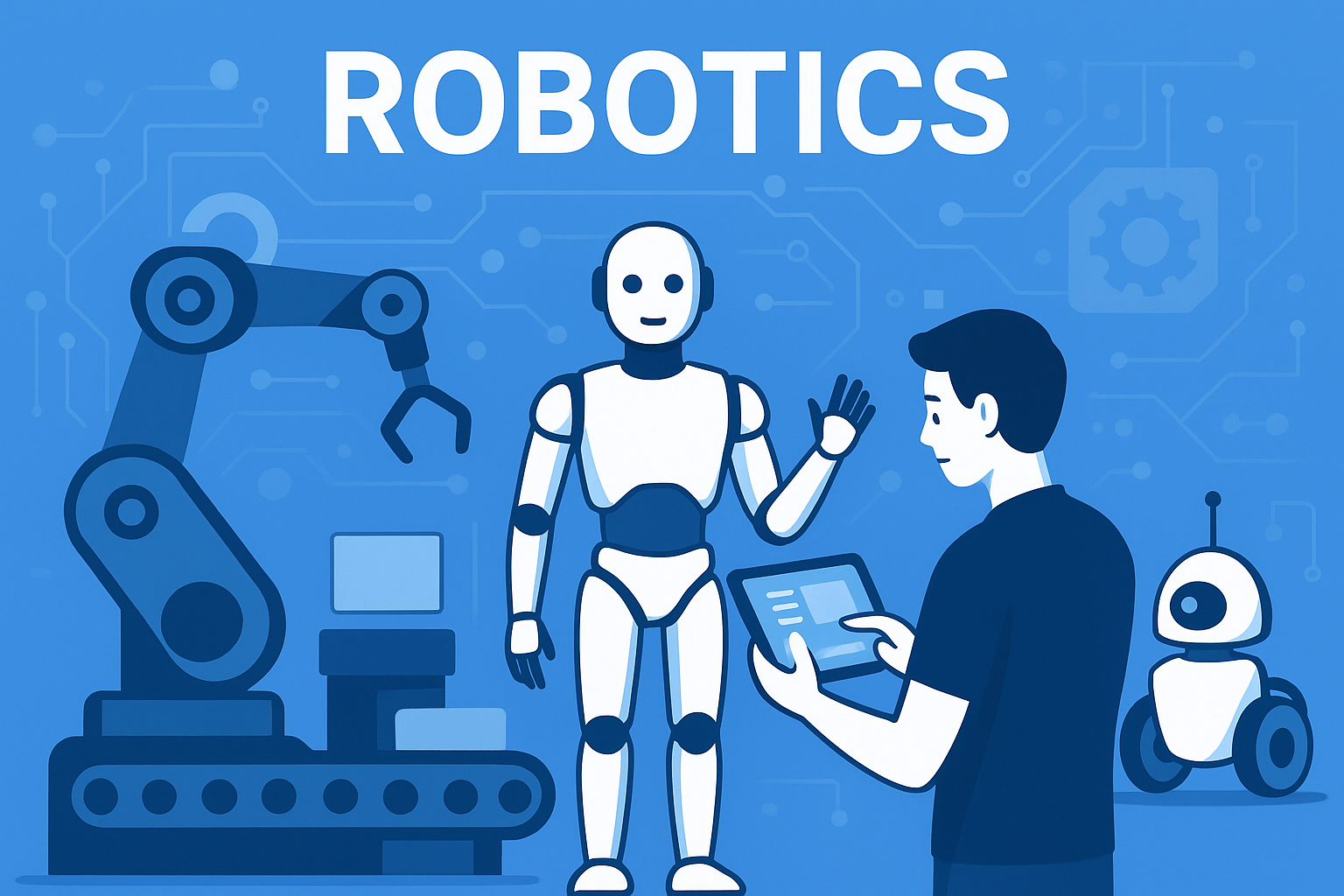Introduction to Robotics
Robotics is one of the most fascinating and fast-growing fields in modern technology, combining engineering, artificial intelligence, and automation to design machines capable of performing tasks traditionally done by humans. From industrial automation to healthcare, robotics is transforming industries and reshaping the future of work and daily life. The development of robotics has created smarter machines, enhanced productivity, and opened doors to countless innovations that continue to evolve every day.
What is Robotics?
Robotics is the interdisciplinary branch of science and engineering that focuses on the design, construction, operation, and application of robots. These robots are programmable machines that can carry out a variety of tasks with little or no human intervention. Robotics integrates fields such as:
- Mechanical Engineering – for designing the structure and movement of robots.
- Electrical Engineering – for powering and controlling robotic systems.
- Computer Science – for programming and artificial intelligence.
- Mathematics – for algorithms, navigation, and precision.
Together, these disciplines allow robotics to serve diverse purposes across industries.
History and Evolution of Robotics
The history of robotics can be traced back to ancient civilizations. Early mechanical devices, such as water clocks and automata, were precursors to modern robots. However, robotics as we know it truly began during the Industrial Revolution, when machines started performing repetitive tasks in manufacturing.
Key milestones in robotics evolution include:
- 1950s – The first industrial robot, “Unimate,” revolutionized automotive assembly lines.
- 1970s-1980s – Growth of robotics in manufacturing and space exploration.
- 2000s – Introduction of service robots in healthcare and household tasks.
- Present – AI-driven robots capable of learning, adapting, and performing complex functions.
Types of Robotics
Robotics can be categorized into several types depending on their applications and design:
- Industrial Robots – Used in factories for assembly, welding, painting, and packaging.
- Service Robots – Provide assistance in healthcare, hospitality, and household chores.
- Medical Robots – Used in surgeries, rehabilitation, and patient monitoring.
- Military Robots – Applied in defense, bomb disposal, and surveillance.
- Exploration Robots – Deployed for space missions, deep-sea exploration, and hazardous environments.
- Humanoid Robots – Designed to mimic human appearance and behavior.
- Collaborative Robots (Cobots) – Work alongside humans in workplaces.
Key Components of Robotics
For a robot to function, it requires several essential components:
- Sensors – Allow robots to perceive their environment.
- Actuators – Enable physical movement and interaction with objects.
- Power Supply – Batteries or other energy sources.
- Control Systems – Programs and algorithms that guide robot behavior.
- End Effectors – Tools or attachments like grippers, welding torches, or surgical instruments.
Applications of Robotics
Robotics plays a critical role in almost every industry today.
1. Manufacturing and Industry
Robotics revolutionized the manufacturing sector by automating repetitive tasks such as welding, painting, and packaging. This improves productivity, reduces human error, and enhances safety.
2. Healthcare and Medicine
Medical robots assist in minimally invasive surgeries, rehabilitation, patient care, and delivery of medication. Robotic prosthetics have given mobility back to millions.
3. Agriculture
Farmers use robotics for automated planting, harvesting, and crop monitoring, reducing labor costs and increasing efficiency.
4. Defense and Security
Robots are deployed for bomb disposal, reconnaissance, and unmanned aerial surveillance, minimizing human risks in dangerous missions.
5. Transportation and Logistics
Robotics powers autonomous vehicles, drones, and automated warehouses. Amazon and other e-commerce giants rely on robots for fast and accurate deliveries.
6. Space and Underwater Exploration
Robotics is essential for exploring hostile environments such as Mars or deep oceans where humans cannot survive.
7. Education and Research
Robotics is widely used as a teaching tool to inspire innovation among students in engineering and computer science.
Robotics and Artificial Intelligence (AI)
Modern robotics is incomplete without artificial intelligence. AI allows robots to “think” and make decisions based on data rather than just executing pre-programmed instructions.
- Machine Learning helps robots improve with experience.
- Computer Vision enables robots to recognize objects, people, and surroundings.
- Natural Language Processing (NLP) allows humanoid robots to understand and respond to speech.
The integration of robotics and AI has given rise to autonomous robots, capable of adapting to new situations and performing tasks with minimal human input.
Benefits of Robotics
Robotics brings numerous advantages:
- Increased productivity and efficiency.
- Improved safety in hazardous environments.
- Enhanced precision in tasks like surgery and manufacturing.
- Reduction in human error.
- Ability to operate 24/7 without fatigue.
Challenges in Robotics
Despite rapid progress, robotics faces challenges:
- High costs of development and deployment.
- Ethical concerns about job displacement.
- Safety risks if robots malfunction.
- Limited adaptability in complex, unpredictable environments.
Future of Robotics
The future of robotics looks promising, with advancements expected in:
- Healthcare – AI-powered surgical robots and patient care assistants.
- Smart Homes – Domestic robots for cleaning, cooking, and personal assistance.
- Autonomous Vehicles – Widespread adoption of self-driving cars.
- Space Colonization – Robots preparing Mars and other planets for human settlement.
- Industry 5.0 – Human-robot collaboration to combine automation with creativity.
Robotics and Society
The rise of robotics is transforming society. While it creates opportunities for innovation and growth, it also raises concerns about employment and ethics. Governments and organizations must ensure policies that balance technological progress with human well-being.
Conclusion
Robotics is no longer just a futuristic concept—it is already embedded in our daily lives, industries, and global systems. From healthcare to space exploration, robotics is driving innovation, increasing efficiency, and reshaping how we live and work. While challenges remain, the future of robotics promises smarter, safer, and more efficient societies. The integration of artificial intelligence will only accelerate this transformation, making robotics one of the most influential technologies of the 21st century.
